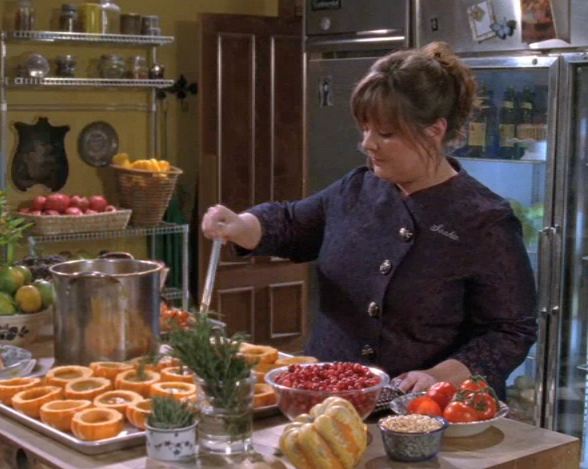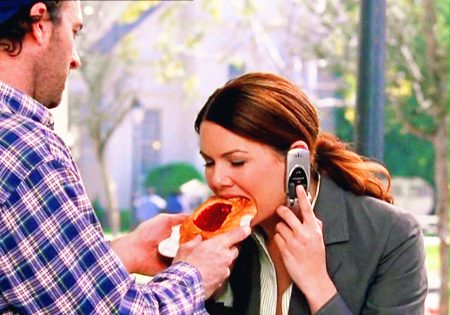 |
| Lorelai Gilmore (Lauren Graham) in Gilmore Girls |
Guest post written by Brianna Low.
Throughout Gilmore Girls’ seven seasons, mother and daughter duo Lorelai and Rory Gilmore are often seen eating vast quantities of junk food and ordering copious amounts of take out, which they consume together, often in front of the TV. From the series’ pilot episode it is made clear that neither Lorelai nor Rory have any interest in cooking, and the only things in their refrigerator are frozen fish sticks and leftover take out boxes. Their idiosyncratic approach to food is framed as just another endearing quirk instead of irresponsible, unhealthy, or an example of bad parenting.
While it could be argued that it is somewhat progressive of the Gilmore Girls series to portray two women who have no hang-ups about publicly consuming large amounts of food, it is important to remember that despite their voracious appetites, Rory and Lorelai are still conventionally attractive, thin, white women. Living in the quirky, depoliticized utopia of Stars Hollow, there is no real examination of the way in which the Gilmore’s racial and class privilege exempt them from the social condemnation that is frequently directed at poor single mothers and women of color whose food choices or weight are often criticized without any real consideration to the inequalities in accessibility to healthy, affordable food. Poor single mothers who rely on social programs like food stamps and have children who suffer from obesity and other related health problems are often publicly vilified for being irresponsible, unfit mothers despite the well-documented structural inequalities in food access and affordability.
Despite their objectively unhealthy diets, Rory and Lorelai manage to escape this specific stigma, both within the context of the show and in its outside criticism; this is due largely, I would argue, to their privilege and even the size of their bodies. While I don’t personally find it problematic that Rory and Lorelai are allowed to eat whatever they want with relative impunity, I do think it is important to place their unhealthy-diet-as-plot-device into a larger social and political context when critically examining the relationship between gender and food within the series.
 |
| Lorelai (Lauren Graham) and Rory Gilmore (Alexis Bledel) in Gilmore Girls; image via Emily Grenfell |
Lorelai and Rory are not the only ones in the Gilmore Girls universe that have well-documented relationships with food. The diets of many of the supporting cast are intrinsic parts of their identities and function as important aspects of their characterization. The mother of Rory’s best friend Lane, Mrs. Kim, is a strict vegan who makes her daughter drink salad water instead of soda. Michele Gerard, concierge of the Independence and Dragonfly Inn, is a health nut that exhibits an almost fanatical devotion to calorie counting and exercise. The diets of these characters in contrast to Rory and Lorelai’s junk food addiction seem to highlight the drastic differences in the way the Gilmore girls like to eat.
Of all of the supporting characters that are connected in some way to food, two of the most notable examples are Lorelai’s best friend and business partner, Sookie St. James, and Lorelai’s friend and romantic interest, Luke Danes. Sookie, played wonderfully by Melissa McCarthy, is the head chef and co-owner with Lorelai of the Dragonfly Inn. She is an extremely talented cook and a compassionate and loyal friend to Lorelai. Her scenes often take place in the kitchen, where she is seen cooking and dispensing advise to Lorelai. While the kitchen has always been a stereotypically feminine space, Sookie’s fixture there does not come off as regressive. Socially, the world of cooking has been sharply demarcated along gender lines, with the personal and domestic sphere belonging to women and the public and professional sphere being dominated by men. Sookie, a master chef and a woman, is portrayed as a highly skilled and respected cook who demands perfection from herself and her employees.
 |
| Sookie St. James (Melissa McCarthy) in Gilmore Girls |
Much has been said about the fact that the character of Sookie, a fat woman who is often surrounded by food, is never reduced to her body-size. It’s true that Sookie is never once shamed for her size or subjected to lazy fat jokes, nor does she express any self-hatred or desire to lose weight. It is somewhat sad and telling that Gilmore Girls has received so much praise for treating a plus-sized character with humanity and compassion, but Sookie’s portrayal is indeed remarkable in a popular culture landscape that almost always essentializes fat women to their bodies and positions those bodies as barriers to happiness and love. Sookie is portrayed as an attractive, confident, and competent woman who is deserving of both romantic attention and respect. Her burgeoning relationship and eventual marriage to Jackson, a vegetable farmer, is fully explored and is not framed as some sort of miracle or only chance at love.
Luke Danes, the gruff and grumpy owner of the local diner, possesses many stereotypical markers of traditional masculinity. Seemingly unsentimental, he is often shown shouting angrily at his neighbors and even his customers, he never changes out of his flannel shirt and backwards baseball cap, and often escapes Stars Hollow on fishing and camping trips in order to relieve his stress. Despite this potentially flat characterization, Luke emerges as a complex character that does in fact care deeply about his friends and his community despite his gruff exterior. Luke is an interesting study when looking at the presentations of masculinity and food in the fictional world of Stars Hollow, particularly in the way he is cast as a nurturer who uses food in order to reach out to and comfort his friends and neighbors.
 |
| Lorelai Gilmore (Lauren Graham) in Gilmore Girls |
Throughout all seven seasons Luke is often shown bringing food to the Gilmore’s when they are in need. For example, when Lorelai’s father is hospitalized after a heart attack, Luke brings food to Lorelai and her family at the hospital. Inasmuch as food can be gendered, diners and diner food fare with its burgers, fries, and malts often tend to be coded as masculine, however Luke is an interesting case in that he refuses to eat his own food. Although he is never explicitly referred to as a vegetarian, Luke is shown refusing to eat hamburgers and often refers to meat as “dead cow”. When Luke and Lorelai start dating and eventually move in together, Luke is decidedly more active in their domestic affairs, taking charge of the cooking and their home remodel. While this might not be the most shocking or unheard of example of stereotypical role reversal in heterosexual relationships, it’s definitely interesting when examining Luke and Lorelai’s relationship with food and each other.
Luke’s Diner itself is also integral to the series as it serves as the physical and communal space in which much of the community gathers. Episodes often open with Lorelai and Rory sitting and eating together in Luke’s Diner. Throughout the series, food serves as the unifying agent that brings people together. When Lorelai is unable to afford private school tuition for Rory, she goes to her wealthy parents, Emily and Richard, in order to ask them for a loan. The elder Gilmores agree to the loan, their only stipulation being that Lorelai and Rory attend weekly “Friday night dinners”. These dinners are an attempt to fix the strained relationship between Lorelai and her parents.
 |
| Gilmore Girls |
Like their daughter, neither Emily nor Richard Gilmore are ever shown cooking, instead the extremely wealthy Gilmore’s have their food prepared for them by personal chefs. The class distinctions between Lorelai and her parents are blatantly obvious and are exhibited in the type of food they consume and the way in which they consume it.
Throughout its seven series run, food plays an integral role in the Gilmore Girl’s universe. While representations of food within the context of the show seemingly transcend stereotypical gender division, food and diet choice are still used to identify and characterize the different personalities that make up the world of Stars Hollow. In the words of Lorelai herself, “It takes years to learn how to eat like we do.”
———-
Brianna Low is currently a student living in Chicago. She enjoys watching movies and reading about feminism.





